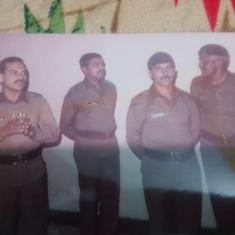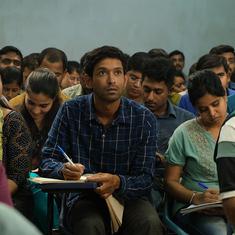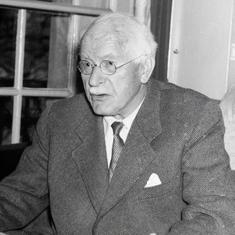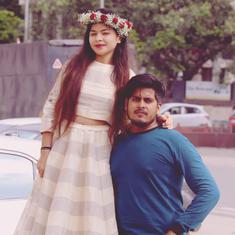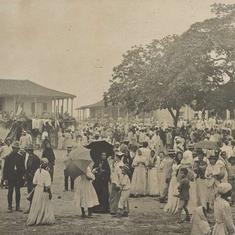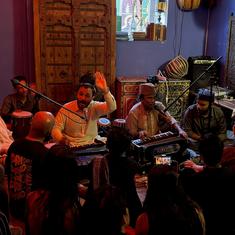‘The young student leader eclipsed the competition and captured the attention of the top state leaders. Priyaranjan Das Munshi and Subrata Mukherjee were a powerful pair at the time. Mukherjee was the home minister of the state. Mamata was introduced to Das Munshi, who declared in everyone’s presence, ‘Mamata gives powerful speeches. You must use her to address college students everywhere.’ Subrata Mukherjee asked her to visit him at home, too. One day Mamata was giving a speech against a Leftist strike at Jagu Babur Bajar near Bhowanipore. Hearing her from his car, Siddhartha Shankar Ray got off to congratulate her. Gradually, Subrata Mukherjee started taking Mamata to the districts.
The Left was very opposed to her, often aggressively so. On one occasion, CPM workers grabbed the mike from Mamata while she was giving a speech at Harinavi. As the violence in student politics began to escalate, Mamata had a head-on battle with the CPM over the issue of gate meetings at the college. CPM workers chased her with pistols, sten guns, bombs and knives through Bhowanipore in broad daylight.
In 1977 the Congress was ousted from power, and the first Left Front government took over. Losing the elections, Das Munshi quit the Congress to start his own party, named Congress (R). But Subrata Mukherjee did not leave. He was the general secretary of the party at the time. His mentor was Pranab Mukherjee, a confidant of Prime Minister Indira Gandhi’s in Delhi, and himself a cabinet minister. Mamata became even more active during this troubled period for the Congress, coming closer to Subrata Mukherjee.
As she herself says, ‘The CPM was a force to reckon with at the time. No one dared take a procession out. My assignment was to take out processions with young men and women from the locality. Bandhs would be called. And we used to take processions out under Subrata Da’s leadership. But his processions inevitably meant bombs and batons and clashes with the police.’ There was still political violence in West Bengal. Three young men died in police firing at Esplanade East on September 22, 1980. Mamata was present at the demonstration that day.
She began to be called wherever there were protests. Madhu Dandavate was the Union Railway Minister. There would be protests against him at Kalyani, so Mamata had to be present, even though it was the day of the preliminary exam of her law course. Mamata left immediately after taking her exam at Law College, where a car was waiting for her. That day, too, the police used batons and opened fire at Kalyani.
In Jammu & Kashmir, three people had been killed in police firing by the Farooq Abdullah government. It was the winter of 1983. Abdullah was to take the 6 a.m. flight from Kolkata to Delhi, a difficult time to stage a protest at the airport. But Mamata was undaunted. She reached the airport with the group of protesters she had gathered the night before and they staged their protest early the next morning.
That year, the Congress Party held its annual session in Kolkata. Rajiv Gandhi was staying at Nizam Palace in the city. Subrata Mukherjee, who was given the responsibility of looking after him, passed this task on to Mamata. So Mamata stayed on duty at the Nizam Palace and caught Rajiv Gandhi’s attention for the first time. Nizam Palace was being renovated and there was a problem with getting hot water. Mamata made sure hot water was delivered in buckets to Rajiv in his first floor room.
Then came the historic moment in Mamata’s life – Indira Gandhi’s assassination. Elections once more. Despite the huge sympathy wave, no one was willing to be the Congress candidate against senior CPM leader Somnath Chatterjee in the party’s ‘Red Fort’ – Jadavpur. Even the central minister, Debi Prasad Chattopadhyay, did not agree despite repeated requests. In her autobiography, Mamata writes, ‘When no one agreed, Pranab Da told Subrata Da, no one’s willing, and Mamata is very young. Check the age certificate and ask her whether she’ll fight the elections. Subrata Da rang me and said, “Pranab Da is asking that you stand in the elections.” “I accept the challenge,” I said.’
Mamata won against all odds, becoming an MP for the first time. She never had to look back after that. No one had imagined that she would succeed in defeating formidable barrister Somnath Chatterjee in a CPM citadel-like Jadavpur. I had joined journalism the same year. Covering the elections in Jadavpur, I learnt what popularity means. It’s true that there was a huge sympathy wave after Indira Gandhi’s assassination, which would have given a boost to any Congress candidate. But with her victory in Jadavpur, Mamata had gained the reputation of a giant-killer.’
Read Didi: The Bengal Tigress by Jayanta Ghosal on the Juggernaut app here (for iOS users) and here (for Android users).
This post was originally published on @juggernautbooks blog The Lowdown.

